
When you first start learning Spanish, building your vocabulary is the most pressing goal.
That's why I recommend you focus on speaking and listening to real, authentic Spanish from the very beginning. Part of your Spanish language journey, however, will include learning specific grammar rules.
In fact, if you've been reading and listening to as much Spanish as possible, you're probably using Spanish indirect object pronouns already!
There will come a point—and maybe you're there already—where you have specific questions about which pronoun to use when.
That's where this article comes in. In it, you will find…
- The difference between direct and indirect object pronouns
- The 6 indirect object pronouns in Spanish
- Which verbs take indirect objects
- Using indirect object pronouns
- How to order direct and indirect object pronouns in the same sentence
If you're confused by direct and indirect object pronouns in Spanish, you're not alone.
But don't worry. By the time you finish this article, you will be able to use Spanish indirect object pronouns right!

Pro Tip
By the way, if you want to learn Spanish through stories, not rules, my top recommendation for language learners is my Uncovered courses, which teach you through StoryLearning®. Click here to find out more and try out the method for free.
So let's get into it. By the way, if you prefer videos, you can also watch me explain Spanish indirect object pronouns here.
Table of Contents
What's The Difference Between Spanish Direct And Indirect Object Pronouns?
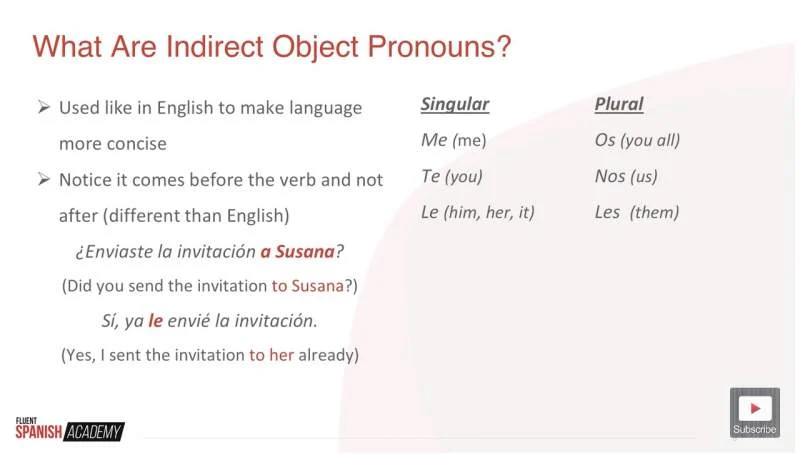
If you've read my article on Spanish direct object pronouns, you'll remember that direct object pronouns are pronouns that replace the direct object that accompanies transitive verbs like llamar (to call), seguir (to follow), and encontrar (to find).
There's also a much more detailed explanation of pronouns and antecedents in that article if you need a refresher of how pronouns work.
Here's a brief reminder of how direct object pronouns work if you don't need the whole explanation again:
The direct object answers the questions “what?” and “whom?” after each transitive verb.
Here's an example:
- Llamé a mi hermano (I called my brother)
- Lo llamé (I called him)
Who did I call? Mi hermano (my brother).
In the second sentence, the pronoun lo replaces mi hermano as the object accompanying the verb llamar (to call).
Indirect object pronouns, on the other hand, answer the questions “to whom?” and “for whom?”
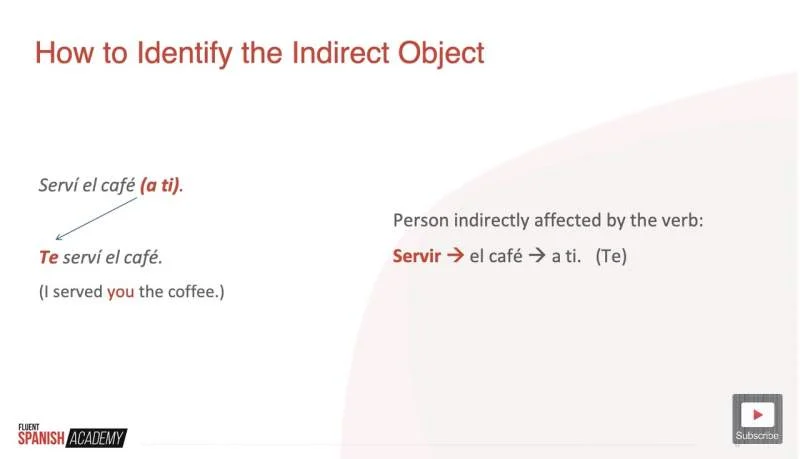
For example…
- Le compré un libro a mi hermano (I bought a book for my brother)
- Le compré un libro (I bought a book for him)
For whom did I buy a book? The answer to that question is the indirect object pronoun in this sentence. I bought the book for mi hermano, which is replaced by the indirect object pronoun le.
And that's the difference between direct and indirect object pronouns:
- Direct object pronouns receive the direct action of the verb. They tell you who or what is called, kicked, searched for, etc.
- Indirect object pronouns are indirectly affected by the verb. They tell you for whom something is bought, given, told, etc.
A List Of Indirect Pronouns In Spanish
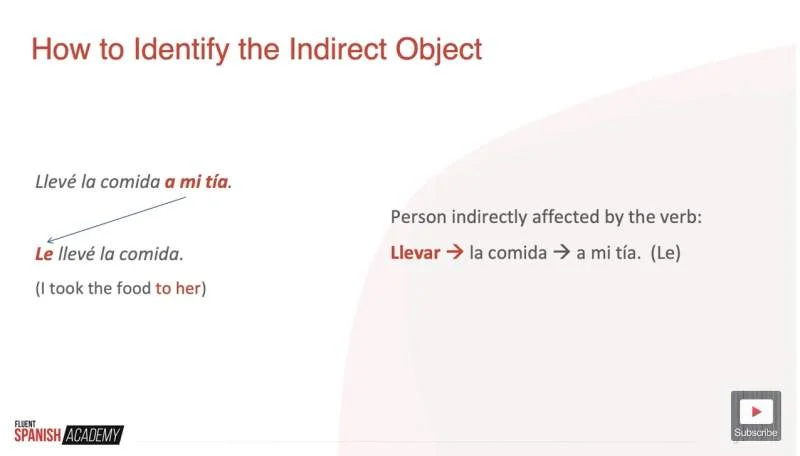
There are only six indirect object pronouns for you to remember in Spanish:
- me (to/for me)
- te (to/for you)
- le (to for him/her, you (formal))
- nos (to/for us)
- os (to/for you (informal, plural)
- les (to/for them, you (plural/formal))
You may have noticed one more practical difference between direct and indirect object pronouns in the previous examples…
Third person indirect objects appear in the sentence even when you also use the indirect object pronoun (the le in our example):
- Le compré un libro a mi hermano (I bought a book for my brother)
That's because the third person indirect object pronouns are not gender specific.
As a result, the indirect object is often stated along with the pronoun to avoid confusion.
Sometimes even native Spanish speakers get a little confused with Spanish indirect object pronouns. Find out more in the video below about le vs les.

Which Spanish Verbs Take Indirect Objects?
Whether or not a verb takes an indirect object depends quite a bit on how the verb is used in the sentence. For example, here are two very similar sentences. In the first, decir does not take an indirect object. In the second, it does.
- Dije que no iría a la fiesta (I said I would not go to the party)
- Te dije que no iría a la fiesta (I told you that I would not go to the party)
Here is a list of verbs that often take indirect objects, when these actions are to or for someone:
- comprar(le) algo (to buy something)
- contar(le)/decir(le) algo (to tell or say something)
- dar(le) algo (to give something)
- mostrar(le) algo (to demonstrate or show something)
- pedir(le) algo (to ask something of someone)
- regalar(le) algo (to gift something)
- servir(le) algo (to serve something)
- traer(le) algo (to bring something)

There are a handful of verbs in Spanish, that always require an indirect object:
- encantarle (to love something)
- faltarle (to miss something)
- gustarle (to like something)
- tocarle (to be someone's turn)
- hacerle falta (to need something)
- importarle (to be interested in)
How To Use Spanish Indirect Object Pronouns
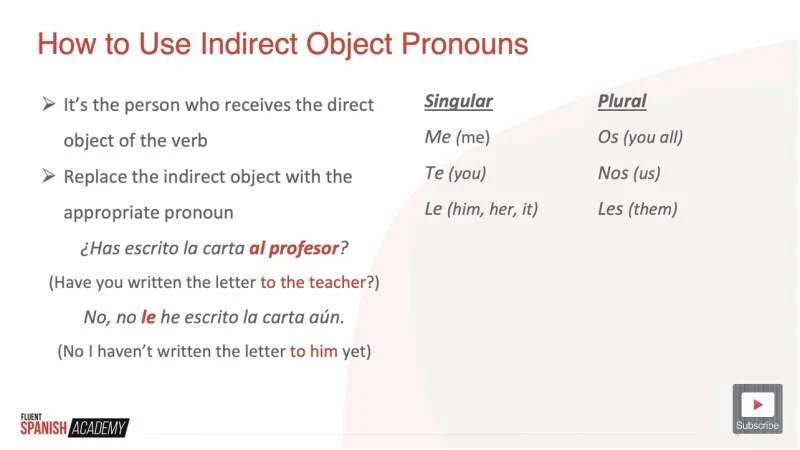
Do you know how to say, “They like to dance” in Spanish? If you do, you already know how to use indirect object pronouns.
Let's take a closer look at some examples:
- Les gusta bailar (They like to dance)
- Josué me regaló un libro de poesía (Joshua gave me a book of poetry)
In these examples, the indirect object pronoun is fairly straightforward. The pronoun comes before the conjugated verb and after the subject.
In the first sentence, the subject is unstated. You could also say, A ellos les gusta bailar. in which case, the subject would come before the indirect object pronoun. ¿De acuerdo?
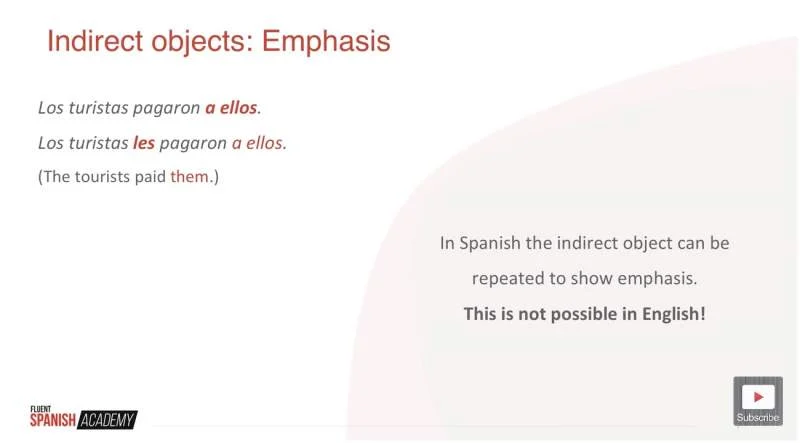
The indirect object pronoun can also be attached to the end of an infinitive or progressive verb…
- Josué quiere regalarme un libro de poesía (Joshua wants to give me a book of poetry)
- Dame esas tijeras (Give me those scissors)
- El profesor está mostrándonos la solución (The professor is showing us the solution)
¡Ojo!: In that last example, notice the accent. Sometimes, when you attach one or more pronouns to the end of a verb, a Spanish accent mark is needed to maintain the natural pronunciation of the verb.
How To Order Direct And Indirect Spanish Pronouns
You can't have an indirect object without a direct object in the same sentence.
Here's an example…
- Andrés nos contó la historia de su viaje a Rumania (Andrés told us the story of his trip to Romania)
In this sentence, Andrés told something (the story of his trip to Romania) to someone (us).
- What he tells is the direct object.
- To whom he tells it is the indirect object.
In fact, we could replace both objects with pronouns and have the following…
- Andrés nos la contó (Andrés told it to us)
Whenever you have a direct object pronoun and an indirect object pronoun in the same sentence, the indirect object pronoun always comes first.
You may remember from the article on direct object pronouns that they are not generally separated from the transitive verb they modify…even by something as small as an indirect object pronoun.

Other Word Order Changes And Examples

And what about when no or another Spanish negation is part of the sentence? How does that change the pronoun order?
In general, the negative word comes immediately before the direct and indirect object pronouns…
- Andrés nunca nos la contó (Andrés never told it to us)
…except when the pronoun is attached to the end of the verb. In those situations, the negative term comes immediately before the verb or verb clause instead:
- Josué no quiere regalarme un libro de poesía (Joshua doesn't want to give me a book of poetry)
Let's look other examples of Spanish direct and indirect object pronouns in the same sentence:
- Su hermano va a comprarme el boleto. / Su hermano va a comprármelo (Her brother is going to buy me a ticket. / Her brother is going to buy it for me)
- No quiero hacerles la pregunta. / No quiero hacérsela. (I don't want to ask them the question. / I don't want to ask them it)
Notice that le/les becomes se when followed by an indirect object pronoun.
What about this sentence that appears to only have an indirect object:
- Eric nos escribe cada semana (Eric writes to us every week)
Remember, what he writes is the direct object while to whom he writes is the indirect object.
So what does Eric write? In this case, the direct object is unstated. Eric writes letters or emails every week, but he does write something.
And to whom does he write them? To us!

FAQs About Spanish Indirect Object Pronouns
What is the rule for indirect object pronouns in Spanish?
The rule for indirect object pronouns in Spanish is that they represent the person/s who receive the direct object of the verb.
They tell you for whom something is bought, given, told, etc. They replace the indirect object of a sentence.
There are six indirect object pronouns in Spanish:
-me (for me) Me compré un libro (I bought myself a book.)
-te (for you) Te compré un libro (I bought you a book.)
-le (for him/her, you) Le compré un libro (I bought him/her/you a book.)
-nos (for us) Él nos compró un libro (He bought us a book.)
-os (for you, plural) Os compré un libro (I bought you guys a book.)
-les (for them or you, plural) Les compré un libro (I bought them a book.)
What is a Spanish indirect object pronoun example?
If you know how to say a simple phrase like “They like to dance” in Spanish, you already know how to use indirect object pronouns.
Let's take a closer look at some examples:
Les gusta bailar (They like to dance)
Josué me regaló un libro de poesía (Joshua gave me a book of poetry)
In these examples, the indirect object pronoun is fairly straightforward. The pronoun comes before the conjugated verb and after the subject.
What is the difference between IOP and DOP in Spanish?
The difference between IOP and DOP in Spanish is:
Direct object pronouns receive the direct action of the verb.
They represent the person or thing directly affected by the verb's action, and tell you who or what is called, kicked, searched for, etc.
Indirect object pronouns are indirectly affected by the verb. They tell you the recipient or beneficiary of the action, that is, for whom something is bought, given, told, etc.
Here's an example:
Andrés nos contó la historia de su viaje a Rumania (Andrés told us the story of his trip to Romania.)
In this sentence, Andrés told something (the story of his trip to Romania) to someone (us). What he tells is the direct object. To whom he tells it is the indirect object.
If we replace both objects with the pronouns, we can see the difference between them:
Andrés nos la contó (Andrés told it to us)
Nos is the indirect object pronoun, and la the direct object pronoun.
What are 5-10 words in Spanish that often use indirect object pronouns with them?
These are 8 verbs that often take indirect object pronouns with them, when these actions are to or for someone:
1. Comprar (to buy) – Juan le compra un regalo a María (Juan buys a gift for María).
2. Contar (to tell or say) – Pedro va a contarle un secreto a Carlos (Pedro is going to tell Carlos a secret).
3. Dar (to give) – El alcalde le dio la llave de la ciudad al actor (The mayor gave the city key to the actor).
4. Mostrar (to demonstrate or show) – Vengan conmigo, que quiero mostrarles algo especial (Come with me, I want to show you something special).
5. Pedir (to ask) – El entrenador nos pidió que diéramos nuestro mayor esfuerzo (The coach asked us to give our biggest effort).
6. Regalar (to gift) – Este año quiero regalarte algo que puedas devolver si no te gusta (This year I want to gift you something you can return if you don't like it).
7. Servir (to serve) – ¿Puede servirnos el postre? (Could you serve us dessert?)
8. Traer algo (to bring) – ¿Puedo traeros algo del supermercado? (Can I bring you something from the supermarket?)
When should I attach the indirect and direct object pronoun to the end of a verb?
The indirect object pronoun can be attached to the end of an infinitive or progressive verb:
–Josué quiere regalarme un libro de poesía (Joshua wants to give me a book of poetry)
–Dame esas tijeras (Give me those scissors)
–El profesor está mostrándonos la solución (The professor is showing us the solution)
The direct object pronoun must be attached to the verb when it’s an affirmative command:
–Léanlo (Read it)
And can be attached when the transitive verb is in the infinitive form:
–Voy a leerlo (I am going to read it)
Using Spanish Indirect Object Pronouns With Confidence

Now that you know how to identify the indirect object in a sentence and how to properly use and order Spanish indirect object pronouns, you're ready to use these six little pronouns as often as you want.
In the end, the best way to master indirect object pronouns is to jump right in and follow the rules of StoryLearning by reading books in Spanish. As you read, you'll see Spanish indirect object pronouns popping up again and again and they'll soon become second nature.
Mistakes will happen, but they will be less common than you think!
Don't let fear keep you from making the most of the Spanish language and using both Spanish direct and indirect object pronouns for convenience and fluency.
Want To Become A Spanish Grammar Hero?

If you've enjoyed this post, and want to tidy up your Spanish Grammar even more, you're going to love Spanish Grammar Hero.
Grammar Hero will help you master Spanish grammar the natural way, so you can speak with authenticity & communicate with freedom! The programme is for low intermediate and intermediate learners (A2-B1 on the CEFR).
It works by providing you the “Controlled Immersion” you need to internalise the core grammar of Spanish, so you can allow your personality to shine by speaking with accuracy, confidence, and natural flair.
To create Grammar Hero, I took my combined years of language learning, where I tried everything from total immersion and foreign travel, to self-study and professional tuition…
And created a programme that takes the most powerful elements of each, so you can enjoy the benefits of my years of trial and error, from the comfort of your living room.
The result is a programme that condenses potentially years of frustrating, traditional study into a “fast-track” experience that will transform your grammar in the next 90 days. Click here to find out more.

Olly Richards
Creator of the StoryLearning® Method
Olly Richards is a renowned polyglot and language learning expert with over 15 years of experience teaching millions through his innovative StoryLearning® method. He is the creator of StoryLearning, one of the world's largest language learning blogs with 500,000+ monthly readers.
Olly has authored 30+ language learning books and courses, including the bestselling "Short Stories" series published by Teach Yourself.
When not developing new teaching methods, Richards practices what he preaches—he speaks 8 languages fluently and continues learning new ones through his own methodology.









































